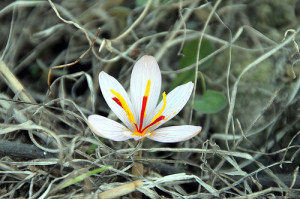There are many compounds in wine that contribute to the aroma and flavor of each, though only a small fraction of those have high enough concentrations to actually have distinctive aromatic characteristics from just one individual compound. Most aromatic qualities are a result of multiple compounds interacting with one another and with the molecular environment around them, which ultimately gives us the complex aroma, bouquet, and overall flavor of the wine. Quite some time ago, we covered one compound in particular; rotundone, and how it possesses a distinct peppery aroma/flavor and how this compound may be responsible for this characteristic in some wines (read that article here).
There are still many compounds in wine that have yet to be identified, in terms of linking them to a specific flavor or aromatic characteristic. By knowing the chemical compound(s) that contribute to specific aromatic characteristics of a wine, the winemaker has more flexibility in terms of coaxing out that
![Photo By Hungry Girl (originally posted to Flickr as Glass of wine) [CC-BY-2.0 (http://creativecommons.org/licenses/by/2.0)], via Wikimedia Commons](http://www.academicwino.com/wp-content/uploads/2014/02/red-wine-the-academic-wino-300x199.jpg)
Photo By Hungry Girl (originally posted to Flickr as Glass of wine) [CC-BY-2.0 (http://creativecommons.org/licenses/by/2.0)], via Wikimedia Commons
The extremely short study presented today (I’m guessing they were really doing a completely separate study and this result was an after-thought that they were able to get published) examined one compound in particular, β-Isophorone (3,5,5-trimethyl-3-cyclohexen-1-one), as it derived from the breakdown of certain carotenoids, the latter of which have been closely examined in contributing to the aromatic and flavor characteristics of wine. In industrial settings, β-isophorone is used as an intermediate compound to astaxnthin and also Vitamin E. Alpha-isophorone, a compound very similar to β-isophorone with the exception of its physical structure, is known to have a peppermint-like aroma in its liquid form,
and is used as a solvent in printer ink, paints, and adhesives, and can also be found in a few essential oils. Finally, both α- and β-isophorone have been found to be contributors to the aromatic profile of the spice saffron.What about grapes? Is β-isophorone present in grapes? Results could help winemakers further refine the aromatic characteristics of their wine by manipulating the compounds that they want in order to create the style of wine that they are trying to make.
Methods
Samples of grapes from 45 different varieties of Vitis vinifera were harvested in the 2011 and 2012 vintages from the CRA-VIT Vine Germplasm Collection in Veneto, Italy. 100 berries of each variety were picked from 5 different clusters on 5 vines each.
β-isophorone was measured and analyzed using Gas chromatography/mass spectrometry (GC-MS).
Results
- Out of the 45 grape varieties studied, only 4 of them were significant for β-isophorone:
- Barbera
- Refosco dal Peduncolo Rosso
- Ribolla gialla
- Rossese
- The presence of β-isophorone was confirmed to be in these four grape varieties for both the 2011 and 2012 vintages.
- Concentrations of β-isophorone in these 4 varieties ranged from 0.6 to 1.2μg/kg per grape.
Conclusions
One thing I really love about short communications in scientific journals is the fact that they are just that-short! No dilly dallying around—get in, get it done. Boom. Science is fascinating, regardless of whether it’s a 4 page paper or a 40 page paper!
Like I said: this paper was short and sweet. Scientists have idea à Scientists test idea à Results found.
In this case, the researchers sought to examine the simple question of whether or not the carotenoid precursor, β-isophorone, a compound found in saffron, is found in wine grapes or not. After testing 45 different varieties over two years, the answer is yes. While not all grapes contained β-isophorone, the varieties Barbera, Refosco dal Peduncolo Rosso, Ribolla gialla, and Rossese all contained β-isophorone
at concentrations between 0.6 and 1.2μg/kg.
How much exactly is 0.6 to 1.2μg/kg per grape? Well, the comparison the authors of this study gave was to saffron itself. β-isophorone levels in the spice, saffron, have been reported to be between 1.6 and 6.6ug/kg. While these levels are higher in saffron than they are in the aforementioned four wine grapes, the upper level found in wine grapes and the lower level found in saffron are very close. Could saffron aromas be contributing to the aroma and/or flavor profile of Barbera, Refosco dal Peduncolo Rosso, Ribolla gialla, and Rossese grapes and wine? It is certainly a possibility!
Further studies should examine these concentrations of β-isophorone a little closer, to determine if these levels found in grapes are, in fact, above the sensory threshold of the compound. Also, further studies should examine grapes grown in multiple vineyards and multiple winegrowing regions, to confirm if these results are repeatable, or if it is something unique to this particular test vineyard that is producing this compound in these grapes.
Knowing that β-isophorone, a compound found to contribute to the aromatic profile of saffron, is present in some grape varieties, winemakers may be able to manipulate and fine tune the optimization of these compounds in order to achieve the saffron-like aroma that is desired.
Have you all ever noticed any hints of saffron in Barbera, Refosco dal Peduncolo Rosso, Ribolla gialla, or Rossese wines? Any other wines not listed here? Please feel free to share your comments and experiences!

![Photo By Miansari66 (Own work) [Public domain], via Wikimedia Commons](http://www.academicwino.com/wp-content/uploads/2014/02/saffron-the-academic-wino-300x225.jpg)

2 comments for “Saffron Aroma Compound β-isophorone Identified in Some Wine Grapes”